Peek Delta Printer
-
Nice!
I have a possible print job where Ultem 1010 would suit me well (I need operation up to 200C). I am seriously wondering if I could print that. Heaters are not an issue; bed already does 200C without sweating, hotend (watercooled Chimera) would need a PT100 or thermocouple and possibly a more powerful heater. Not too intrusive or expensive to archieve.
My main issue is the chamber temperature. I have no active heating anymore, so with the bed at 160C the temperature inside the build chamber probably rises to 60-70C or so, but not much further. I wonder if that is enough? Maybe carbon-filled filament would help to reduce warping?
Do you have any experience with that? Ultem 1010 filament is hard to obtain as sample, and the cost of a spool is not at a 'oh well, let's buy one and see where it ends' level.
-
@DaBit i use a water cooled chimera with a pt100 and the high temperature heater, copper heater block and copper plate nozzle available from e3d online. The chamber/print is heated by ir strip heaters which are idea for the delta printer as the bed is fixed.
For ultem 1010 really need a chamber of 110 plus and the cost although for the filament is much cheaper than printing PEEK. Higher the chamber temperature helps layer bonding, stops warping and reduces the thermal stresses in the printed part, although you can anneal it after printing.
What type of printer do you have? Do you have a picture of it? If you are interested in the ir strip setup i post details and suppliers etc.
-
@andornot said in Peek Delta Printer:
@DaBit i use a water cooled chimera with a pt100 and the high temperature heater, copper heater block and copper plate nozzle available from e3d online. The chamber/print is heated by ir strip heaters which are idea for the delta printer as the bed is fixed.
For ultem 1010 really need a chamber of 110 plusHmm. Since I am not planning to print hightech plastics like PEI or PPS on a daily basis I could do the IR temporarily. If I can keep the IR off the print head and illuminate the print only it might work for PEI.
Higher the chamber temperature helps layer bonding, stops warping and reduces the thermal stresses in the printed part, although you can anneal it after printing.
I am not that interested in PEEK yet; it is extremely expensive and the PEEK parts I need can usually be machined quite effectively from round stock or plate.
'lower grade' engineering plastics like PEI and PPS however, well, those would suit me more often. Both for chemical resistance and temperature resistance.What type of printer do you have? Do you have a picture of it? If you are interested in the ir strip setup i post details and suppliers etc.
A DIY printer of course

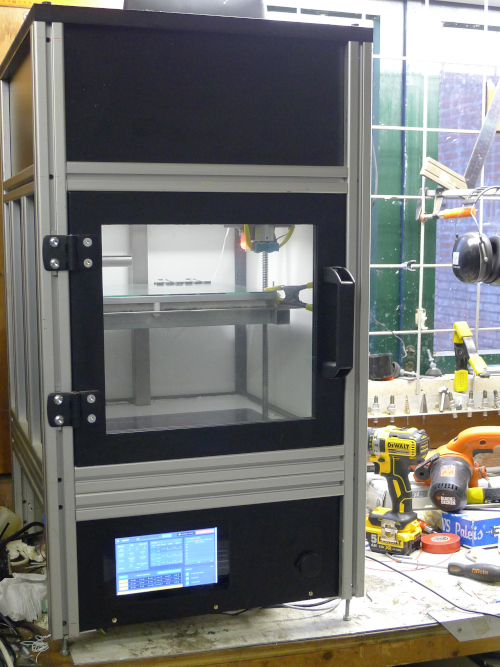
The printer is a CoreXY, the chamber is closed and insulated. The door is double glass, the aluminium inside is insulated using Armaflex, lighting inside is fluorescent lighting so it can handle some heat as well. But 120C would be too much, it was designed for 90C.
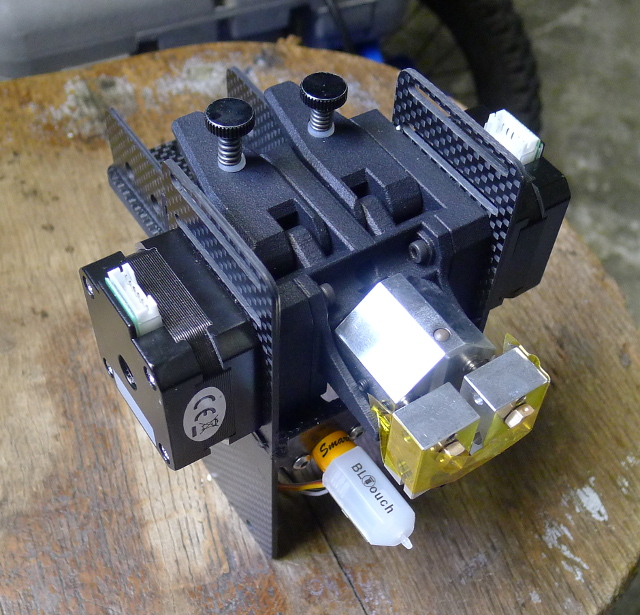
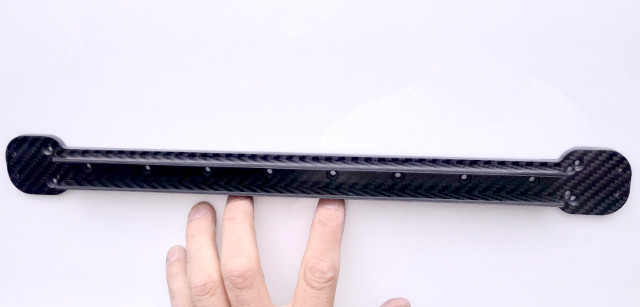
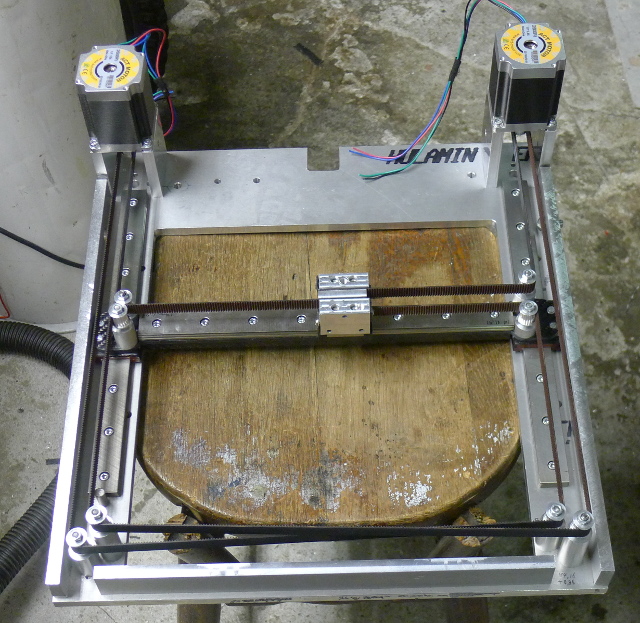
Print head and gantry is made from carbon fiber using a Bondtech BMG-X2 and watercooled E3D Chimera in direct drive configuration.
A CoreXY constructed from tooling plate, Rexroth linear rails and Gates belts move the Chimera around. I used to have to CoreXY motors at the bottom of the printer with shafts running to the CoreXY, but no more.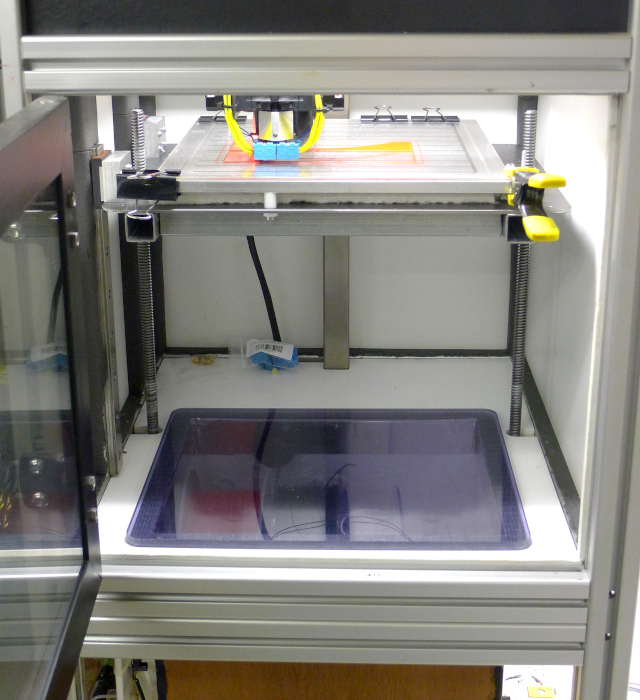
Filament is stored dry in the printer itself, the filament path to the head is fully enclosed (PTFE tube from filament storage to head)
It used to have a heated chamber, mainly for ABS/ASA, but the airflow gave me too much trouble, and the material choices are not optimal either. Aluminium as carrier for the CoreXY, steel (Rexroth) linear rails, carbon gantry; the thermal expanion coefficients are too different. Oh well, I used what I had or what I could obtain for little money. We all do that. Basically the entire printer structure is built using other peoples trash.
In the end the print results were better by leaving the chamber heater off and just leaving the hotbed running for half an hour to heat the chamber.
So when I rebuild the thing using a Duet and Chimera+ I removed the chamber heater, moved the stepper motors in the chamber close to the CoreXY and used the space taken preeviously by the heater as dry filament storage instead.I think I am going to regret that decision.....
I am contemplating a printer made entirely out of steel using 20mm pitch ballscrews for movement and independent extruders. Then use liquid cooling to keep all stepper motors below 80C, no plastic in the direct drive extruders, and using chamber temperatures way above 100C should not be an issue at all.
But not yet. Such a printer would cost me at least 1500 euros to build. Let's finish this one first and gain a bit more experience. -
@DaBit IR maybe a good for your machine as you are only heating up the part, but your bed moves unlike a delta printer. My machine has a thermocouple on the end effector with a black heatshrink sheath to measure the temperature close to where you are printing and i have been monitoring the sides an they get up to a max of 40 degrees with chamber at 110 degrees. If you go down this route try to eliminate black or dark colours, i have changed most to reflect the IR.
-
The bed moves, but I could locate the IR heaters on the bed itself since I am planning to print fairly flat parts that do not occupy the entire build area anyway. A couple of IR tubes, some aluminium sheet to direct the IR and indeed, a thermocouple to measure the temperature close to the print location and a separate 1/16 DIN controller to control the IR tubes. Hmm, might work, even with low IR intensities. Especially when I try to source carbon filled PEI.
-
The latest upgrade to my high temperature delta print, fully insulated with aluminium backed rock wool. Also i am printing on glass using vision miners nano adhesive to print peek and ultem, its good stuff but not cheap, i would certainly recommend it.

-
It certainly looks nice.
No issues with the belts and higher temperatures? -
@DaBit they are holding up but i am changing the design to move the slideways and belts to the outside of the machine. It will look ugly and fit for function long term i will redesign, this will allow 200 plus temperatures in the chamber.
-
It is itching...
I think I found a couple of free ballscrews+fixed bearings, just have to pick them up and check out their condition. I know where to get some lineair rail. And I know a guy with a CNC plasmacutter who is willing to return me a favor.
Replace all plastic parts on the screws and rails with metal, and they should easily be capable of handling 120-200 degrees C environment; it mainly depends on the grease used. A chassis entirely made from plasma cut and welded sheet steel is resistant too, and the sheet steel can be heated with some silicone heaters to heat the entire chamber without disturbing airflow. Motors can be shrouded and liquid cooled. And two Hemera-like extruders in an IDEX configuration can be duplicated in full metal with liquid cooling. Due to everything being steel the structure distortion due to heat should be minimal.
The itch, ooooh, the itch...
-
Looks great. Gates belts are rated to 80 C. So are most linear motion components, so it's a good match for a heated chamber.
-
Hi!
I know this is old but may i ask a few questions?
first of all how did you get your rails to handle 150! genuine stuff only handle 100c max, and cloned do 85-100 depending on where you get it afaik.how much did this cost?
what's the difference between your ambient temperature and part temperature with the IR light blasting on it. what advantages does it have over just regular air? does the radiation also heat up your printed parts?
have you had any luck with getting PC to survive there? I was thinking of covering my printed parts in aluminum foil so radiation bounces off. leaving my parts cool enough in theory. -
@amythebun said in Peek Delta Printer:
[...]
first of all how did you get your rails to handle 150! genuine stuff only handle 100c max, and cloned do 85-100 depending on where you get it afaik.
[...]These rails are rated for 150 C.